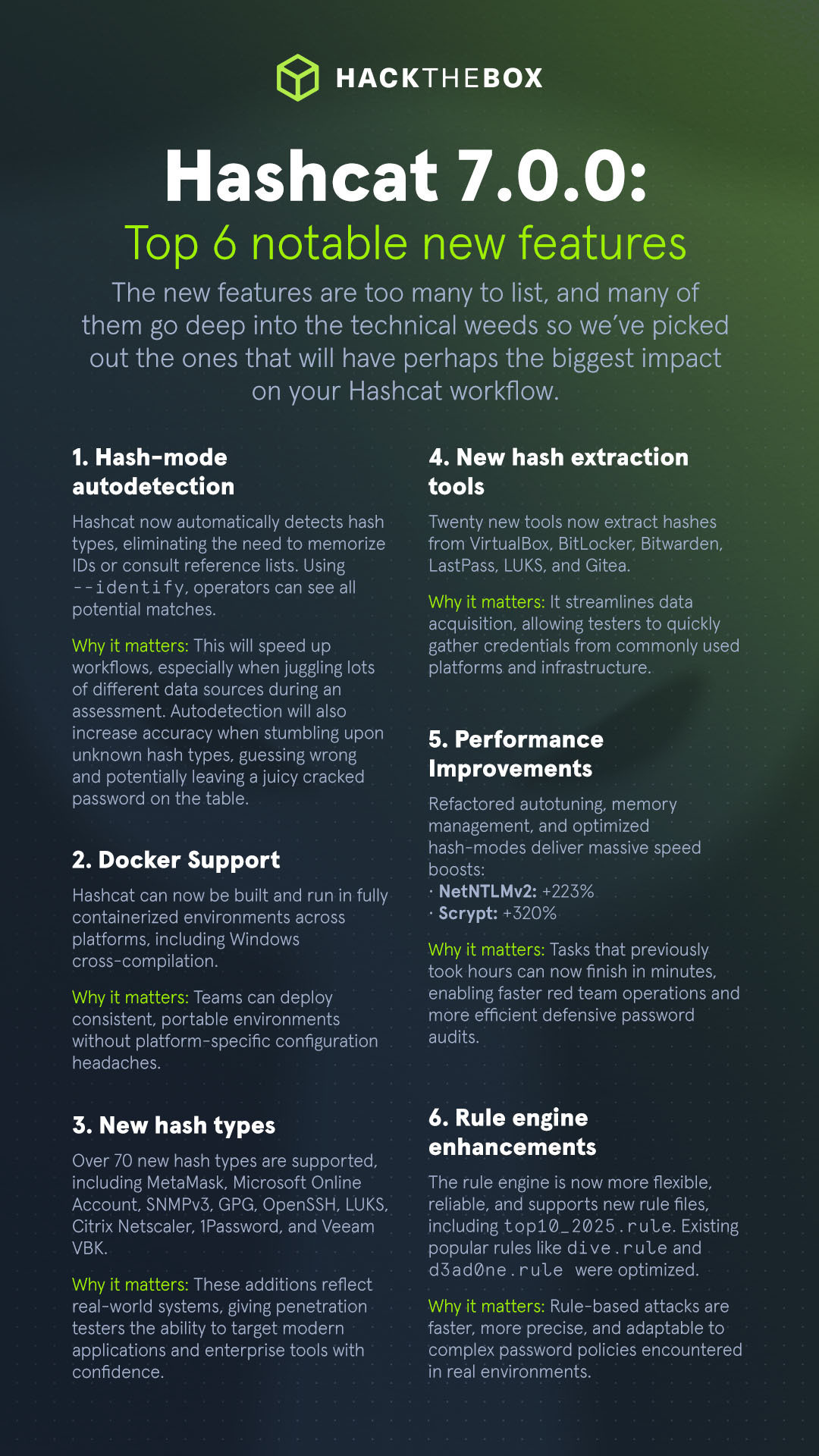Security 101
Hashcat 7.0.0 is here: Massive update for password crackers & security pros
Hashcat 7.0.0 is here with major speed boosts, new hash types, Docker support, and smarter rules. Learn how this release empowers pentesters, red teamers, and defenders.

mrb3n,
Sep 18
2025
Table of Contents
The Hashcat team released a major update on August 1, 2025, with version v7.0.0—the first major release in over two years.
This update represents over 900,000 lines of changed code and contributions from 105 community members, including 74 new contributors. It also merges and fully documents features that had been quietly released in previous 6.2.x versions, but had never been officially announced.
Here’s why it matters: Password cracking isn’t just a CTF exercise; it’s a critical step in real-world attacks. Whether you’re a penetration tester, red teamer, or a security admin auditing credentials, Hashcat 7.0.0 offers new capabilities that make cracking faster, more accurate, and more scalable than ever.
Hashcat 7.0.0: Top 6 notable new features
The new features are too many to list, and many of them go deep into the technical weeds so we’ve picked out the ones that will have perhaps the biggest impact on your Hashcat workflow.
1. Hash-mode autodetection
Hashcat now automatically detects hash types, eliminating the need to memorize IDs or consult reference lists. Using --identify, operators can see all potential matches.
Why it matters: This will speed up workflows, especially when juggling lots of different data sources during an assessment. Autodetection will also increase accuracy when stumbling upon unknown hash types, guessing wrong and potentially leaving a juicy cracked password on the table.
2. Docker support
Hashcat can now be built and run in fully containerized environments across platforms, including Windows cross-compilation.
Why it matters: Teams can deploy consistent, portable environments without platform-specific configuration headaches.
3. New hash types
Over 70 new hash types are supported, including MetaMask, Microsoft Online Account, SNMPv3, GPG, OpenSSH, LUKS, Citrix Netscaler, 1Password, and Veeam VBK.
Why it matters: These additions reflect real-world systems, giving penetration testers the ability to target modern applications and enterprise tools with confidence.

4. New hash extraction tools
Twenty new tools now extract hashes from VirtualBox, BitLocker, Bitwarden, LastPass, LUKS, and Gitea.
Why it matters: It streamlines data acquisition, allowing testers to quickly gather credentials from commonly used platforms and infrastructure.
5. Performance Improvements
Refactored autotuning, memory management, and optimized hash-modes deliver massive speed boosts:
-
NetNTLMv2: +223%
-
Scrypt: +320%
Why it matters: Tasks that previously took hours can now finish in minutes, enabling faster red team operations and more efficient defensive password audits.
6. Rule engine enhancements
The rule engine is now more flexible, reliable, and supports new rule files, including top10_2025.rule. Existing popular rules like dive.rule and d3ad0ne.rule were optimized.
Why it matters: Rule-based attacks are faster, more precise, and adaptable to complex password policies encountered in real environments.
The real-world impact for security teams
Hashcat 7.0.0 isn’t just a tool for hobbyists or CTFs. Security teams can now leverage it to:
-
Conduct periodic password audits across enterprise systems
-
Identify weak credentials before attackers exploit them
-
Test cloud and local hashes safely in a controlled environment
Mapping to MITRE ATT&CK, Hashcat supports Credential Access (T1110: Brute Force, Password Spraying) exercises, giving teams the ability to simulate attack scenarios safely.
Try HTB Academy’s Cracking Passwords with Hashcat Module
Final thoughts on Hashcat 7.0.0
The Hashcat 7.0.0 update reflects the power of community-driven open-source tooling. With contributions from hundreds of developers, it’s more scalable, faster, and capable than ever. Red teamers, penetration testers, and blue teamers alike benefit from these improvements:
-
Red teamers: Faster, more accurate attacks across modern hash types
-
Defenders: Ability to proactively audit credentials, identify weaknesses, and implement stronger defenses
Open-source projects like Hashcat remain the backbone of offensive security. Without the dedication of maintainers and contributors, these tools wouldn’t be accessible to security professionals worldwide.
If you want to turn theory into practice, explore the HTB Hashcat module to apply these updates in a hands-on, structured learning environment. Mastering these new features strengthens both offensive and defensive cybersecurity skills.
Latest News
Artificial Intelligence
Benchmarking AI security: Inside the new HTB AI Range
 b3rt0ll0, Dec 03,
2025
b3rt0ll0, Dec 03,
2025














